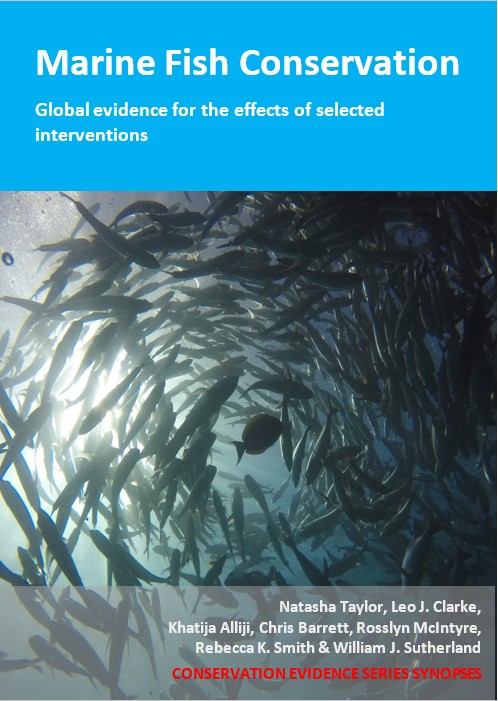Cease or prohibit all fishing activity in a marine protected area with limited exceptions
-
Overall effectiveness category Awaiting assessment
-
Number of studies: 4
View assessment score
Hide assessment score
How is the evidence assessed?
-
Effectiveness
not assessed -
Certainty
not assessed -
Harms
not assessed
Study locations
Supporting evidence from individual studies
A replicated, site comparison study in 1998 of eight rocky and sandy sites in the San Juan Archipelago, northwest Pacific Ocean, USA (Tuya et al. 2000) found no differences in the abundances of copper rockfish Sebastes caurinus, quillback rockfish Sebastes maliger, China rockfish Sebastes nebulosus and lingcod Ophiodon elongatus between voluntary no-take sites (no collection of finfish except for salmon) protected for one year, no-take sites (all collection of marine organisms prohibited except for approved scientific research) protected for eight years, and nearby sites open to fishing. Results were reported only as statistical results (ordination analyses). The authors suggested the lack of increase in fish abundance inside protected compared to non-protected areas was likely due to a lack of compliance and enforcement of the restrictions. In July 1998, two marine protected areas (designated 1997 as voluntary no-take zones where no finfish except salmon could be collected – no gears specified), three research marine reserves (established 1990, extractive activities prohibited except for research, sea urchin fishery closed since late 1970s), and three unprotected openly fished areas were surveyed. Two divers identified and counted fish along 300 m2 transects on reef slopes up to 20 m deep (4 transects/site).
Study and other actions testedA site comparison study in 2003–2008 of two reef areas in the Caribbean Sea, US Virgin Islands (Monaco et al. 2009) found that prohibiting almost all fishing except for bait within a marine protected area resulted in lower fish species richness and density and similar fish biomass compared to adjacent unprotected areas in the seven years after protection. Species richness and fish density was lower inside the protected area than outside (species richness: 24 vs 27 species/100 m2; density 229 vs 294 fish/100 m2) and biomass was similar (inside: 7,900, outside: 8,800 g/100 m2). The Virgin Islands Coral Reef National Monument was established in 2001 to extend the existing Virgin Islands National Park. In the study area, all extractive uses and boat anchoring were prohibited, except for a small area where bait fishing was permitted (no species or gears specified). Annually, in July 2003–2008, protected areas (18–20 sites/year) and fished areas (15–18 sites/year) were surveyed. Divers recorded fish number, length and species along 25 × 4 m belt transects. Biomass was estimated using average length for each size class.
Study and other actions testedA replicated study in 2009–2010 of two shallow coastal areas in the Great Barrier Reef, Coral Sea, Australia (Knip et al. 2012) found that individuals of two shark species displayed frequent and long-term use of marine protected areas prohibiting all fishing (except restricted line fishing and bait netting) for five years, and thus were protected from fishing for a proportion of time. Immature pigeye Carcharhinus amboinensis and adult spottail Carcharhinus sorrah were detected inside protected areas an average of 23% (range 2–67%) and 32% (range 0–67%) of time respectively, and for 4–676 days (average 190 days) and 28–566 days (average 281 days). In addition, the amount of time spent inside protected areas was significantly different between sexes for spottail, but not pigeye, with female spottail spending more time (38%) than males (21%). All the tracked sharks left the protected areas during monitoring, on average 0.9 times/day for pigeye and 1.7 times/day for spottail. Sharks were monitored in two marine protected areas in Cleveland Bay (140 km2) off the wider Great Barrier Reef Marine Park (rezoned in 2003) in which trawling and netting (bait netting excluded) are prohibited and line fishing is limited to one line per person and one hook per line. Sharks are not targeted by the permitted fisheries and 95% are released alive if captured. From 2009 to 2010, tracking data was collected from 37 sub-adult pigeye and 20 adult spottail fitted with acoustic transmitters by 55 underwater receivers deployed inside the two protected areas.
Study and other actions testedA replicated, controlled, before-and-after study in 2005–2013 of three seabed areas in the Skagerrak, Norway (Fernández-Chacón et al. 2015) found that in a marine protected area prohibiting almost all fishing, except for commercial hook and line fishing of cod Gadus morhua and research sampling, cod survival increased over eight years, compared to outside areas where a wider range of fishing gear types were allowed. Overall average survival probability of cod inside the protected area increased after implementation (after: 0.2–0.4, before: 0.1–0.2) and in comparison with areas outside the protected area (after: 0.2, before: 0.2). Sampling was done in April–July 2005–2013. Cod were captured inside the protected area and at two unprotected sites with fyke nets and tagged and released at the capture location. Data on 10,764 recaptures of tagged fish were used: 1,454 tagged within the protected area and 9,310 tagged in other areas along the Skagerrak coast. Survival was estimated using a model, described in the original paper. The protected area (Flødevigen, 1 km2) was implemented in September 2006 and allowed a hook and line fishery and research sampling. At unprotected areas, hook and line, gillnets, fyke nets and other fishing gear types were allowed, but not bottom trawling within 12 nautical miles from the coast, with an exception for small scale coastal trawling for shrimp Pandalus borealis.
Study and other actions tested
Where has this evidence come from?
List of journals searched by synopsis
All the journals searched for all synopses
This Action forms part of the Action Synopsis:
Marine Fish Conservation





)_2023.JPG)














